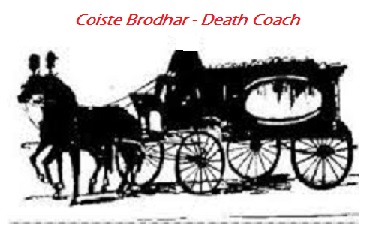Dullahan
Many can remember the scene in Washington Irving’s “The Headless Horseman” where Ichabod Crane was being chased by the spectre when a jack o' lantern was thrown at him. This tale took place in the Dutch occupied Westchester County area of New York, but the creature was definitely Celtic in origin.
The legends of the headless horseman come out of Ireland. There, known as gan ceann, (headless), or dullahan, he would take the soul of those who would be ready for death. He often rode a headless black horse, or if it had a head, had flaming eyes and short-cropped ears that outdistanced its body by six meters or more. He used a human spine as a whip, and would take the eyes of those who stared upon him. He had a head and often carried it or attached it. It is said to look like moldy cheese, or yeasty bread, in both patina and texture. He would also toss it about, in a hideous display of ball control that would bring envy to any G.A.A. footballer. The dullahan also possessed supernatural sight. He would hold his severed head aloft, and look across vast expanses of the countryside, even in pitch dark, allowing him to look into houses of the dying.
Coachman to the Afterlife
The dullahan wasn’t just to be found on a horse. If you were unlucky enough, he might be your coachman to the afterlife, in the death coach. In Irish folklore, it is known as the Cóiste Bodhar, the silent coach. Six black horses draw this, and the horses and coach traveled so quickly that the bushes on the roadsides were known to have started on fire. The locks on houses and gates would open by themselves, thus affirming that no one is immune from the headless one. The sight or sound of the coach announced the imminent death of oneself or a family member.
The coach was best known in Sligo, Tyrone, and some other areas of Ulster. And across the sea, in Scotland, the coach was often seen on Edinburgh’s Royal Mile, gathering up the souls of the dead. In Ireland, in particular, the death coach is seen as a signifier of the inevitability of death, as the belief goes once it has come to Earth it can never return empty. Thus, once the death of an individual has been decided by a greater power, mortals may do nothing to prevent it. And if you opened your door when the coach went by, you would end up with buckets of blood splashed upon your face, or be blinded. If one were lucky, they would carry gold upon their person. The sight of gold would send the dullahan away, back to the depths of the darkness it came.


Ancient Celtic God
Even for the Irish, and the Celts, this is a starkly dark creature. Where did he come from, this headless one? Some people believe that the Dullahan grew out of the ancient Celtic god, Crom Dubh, the dark bent man, a god who asked for human sacrifice. Ironically, he was also the fertility god. He was worshiped in Ireland until the sixth century, when Christianity took a stronger hold on the island, and the practice was stopped. Stopping the sacrifices didn’t stop the belief, however. He might be referred to as far dorrocha, the dark man, or Crom Cruach, the bloody crooked man.
Why Headless?
Then there is the question of why was he headless? The ancient Celts believed the soul was in the head, and if a foe was a worthy one, their head would be taken, to add to the warrior’s prestige. There was also the belief that if they attached the head to a pole near their habitation, the head would scream when the enemy neared. The Celtic headhunters venerated the image of the severed head as a continuing source of spiritual power.

The Green Knight
The dullahan made his way into literature, folk tales, and modern entertainment. The Green Knight, in the medieval story of “Sir Gawain and the Green Knight,” who is otherworldly, greenish in color, hostile, determined to take Sir Gawain’s life and, after Sir Gawain strikes him, headless. W. B. Yeats mentioned the coach and its driver in his book, “Folk Tales of Ireland”. In the movie, “Darby O’Gill and the Little People”, the death coach was used to summon the daughter to travel to the afterlife.
Rip Van Winkle
Why would Washington Irving use the dullahan in his tale? Irving’s family came from Scotland, so he would have heard of those tales of Celtic faeries and ghouls. His father, William, came to the colonies from the island of Shapinsay in the Orkney Islands. The character of Rip Van Winkle is very similar to that of a drunken fiddler who stumbled onto the burial mound of Salt Knowe adjacent to the Ring of Brodgar on the island. And although the series of stories that included the Headless Horseman and Rip Van Winkle were based in the Catskills, he admitted that he had not visited the area before he wrote them. The jack o’lantern was also a part of Irish and Scots legends, having been carved for centuries from turnips and gourds.
Samhain
Each October, the Irish New Year, Samhain, brings the end of the Irish fall and the beginning of the Celtic winter. The new year rises from the greyness of the season, and the dead walk with their living relatives, and pucas and demon brides, and the far liaths all come to visit, look out for the dullahan. Or, better yet, look away, and carry a piece of gold. One can never be safe enough.
Happy Halloween and Happy New Year.